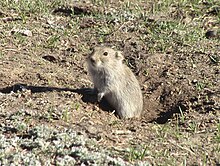Brandt's vole
| Brandt's Vole | |
|---|---|
 | |
| Scientific classification | |
| Domain: | Eukaryota |
| Kingdom: | Animalia |
| Phylum: | Chordata |
| Class: | Mammalia |
| Order: | Rodentia |
| Family: | Cricetidae |
| Subfamily: | Arvicolinae |
| Genus: | Lasiopodomys |
| Species: | L. brandtii |
| Binomial name | |
| Lasiopodomys brandtii (Radde, 1861) | |
| Synonyms | |
| L. aga (Kastschenko, 1912) | |
Brandt's vole,[1] (Lasiopodomys brandtii), also known as the steppe vole, is a species of rodent in the family Cricetidae. It is native to shrublands and grasslands in Russia, Mongolia and northern China.[1]
Characteristics[edit]
Brandt's vole is about 15 cm (5.9 in) long with a tail up to 3.5 cm (1.4 in) long. Its ears are small and the short fur is uniform sandy-brown, paler underneath. The tail is entirely brown and there are dense hairs on the hind part of the feet.[4]
Distribution and habitat[edit]
Brandt's vole is found in Nei Mongol, Jilin, and Hebei provinces in north-east China,[2] in Mongolia and southern Transbaikalia in Russia. Brandt's vole is commonly found in grassland areas.[5] Its typical habitat is dry steppes and pastures. Its sometimes also found in lakeside meadows and river valleys.[4]
Behaviour and ecology[edit]
Brandt's vole is a colonial species. Each family establishes a network of burrows with several entrances, long passages, storerooms, and nesting chambers. The voles are active during both the day and night and their behaviour varies at different times of year.[6] They feed on both the underground and aerial parts of plants. Large stores of food are laid up before the winter and the energy intake of the voles seems to be correlated with the length of day.[7] There are four or five broods each year, with each litter consisting of about seven young. Population levels are subject to wide swings. Under unfavourable conditions, this vole can be wiped out of some of the regions in which it is normally found, but when the conditions are right, mass outbreaks can occur. This periodically happens in Mongolia when millions of hectares of pasture are invaded. Under this onslaught, the pastures can become very bare, poor subsoil can be brought to the surface by burrowing activities and coarse weeds can become established, seriously harming the grazing for domestic animals.[4]
Cold adaptations[edit]
When exposed to cold temperatures, voles increase their resting metabolic rate.[8] This increase is caused by increased activity from mitochondria in the vole's brown fat, as more energy is used in nonshivering thermogenesis to generate heat. Nonshivering thermogenesis, decreased serum leptin levels, fat mobilization, and hyperphagia are all associated adaptations that the Brandt's voles undergoes in cold environments.[9] Hyperphagia leading to increased food intake is highest in colder months, but voles expend so much energy during this period that they weigh less in summer months.[10]
References[edit]
- ^ a b c Avirmed, D.; Batsaikhan, N. & Tinnin, D. (2017) [errata version of 2016 assessment]. "Lasiopodomys brandtii". IUCN Red List of Threatened Species. 2016: e.T11340A115101423. doi:10.2305/IUCN.UK.2016-3.RLTS.T11340A22351917.en. Retrieved 25 December 2021.
- ^ a b Wilson, D. E.; Reeder, D. M., eds. (2005). Mammal Species of the World: A Taxonomic and Geographic Reference (3rd ed.). Johns Hopkins University Press. ISBN 978-0-8018-8221-0. OCLC 62265494.
- ^ "Lasiopodomys brandtii". Integrated Taxonomic Information System. Retrieved 16 December 2023.
- ^ a b c AgroAtlas
- ^ Dai, Xin; Zhou, Ling-Yu; Xu, Ting-Ting; Wang, Qiu-Yue; Luo, Bin; Li, Yan-Yu; Gu, Chen; Li, Shi-Ping; Wang, Ai-Qin; Wei, Wan-Hong; Yang, Sheng-Mei (2020-03-11). "Reproductive responses of the male Brandt's vole, Lasiopodomys brandtii (Rodentia: Cricetidae) to tannic acid". Zoologia. 37: 1–11. doi:10.3897/zoologia.37.e52232. ISSN 1984-4689.
- ^ Seasonal changes of the activity patterns of Brandt’s vole (Lasiopodomys brandtii) in the typical steppe in Inner Mongolia
- ^ Zhao, ZJ; Wang, DH (2006). "Short photoperiod influences energy intake and serum leptin level in Brandt's voles (Microtus brandtii)". Horm Behav. 49 (4): 463–9. doi:10.1016/j.yhbeh.2005.10.003. PMID 16293255. S2CID 34683241.
- ^ Zhang, X.-Y. & Wang, D.-H. (2006). "Energy metabolism, thermogenesis and body mass regulation in Brandt's voles (Lasiopodomys brandtii) during cold acclimation and rewarming". Hormones and Behavior. 50 (1): 61–69. doi:10.1016/j.yhbeh.2006.01.005.
- ^ Tang, G.-B.; Cui, J.-G. & Wang, D.-H. (2009). "Role of hypoleptinemia during cold adaptation in Brandt's voles (Lasiopodomys brandtii)". American Journal of Physiology. Regulatory, Integrative and Comparative Physiology. 297 (5): R1293–R1301. doi:10.1152/ajpregu.00185.2009.
- ^ Li, X.-S. & Wang, D.-H. (2005). "Regulation of body weight and thermogenesis in seasonally acclimatized Brandt's voles (Microtus brandti)". Hormones and Behavior. 48 (3): 321–328. doi:10.1016/j.yhbeh.2005.04.004.
- Musser, G.G.; Carleton, M.D. (2005). "Species Lasiopodomys brandtii". In Wilson, D.E.; Reeder, D.M (eds.). Mammal Species of the World: A Taxonomic and Geographic Reference (3rd ed.). Johns Hopkins University Press. pp. 894–1531. ISBN 978-0-8018-8221-0. OCLC 62265494.
- Dai, Xin; Zhou, Ling-Yu; Xu, Ting-Ting; Wang, Qiu-Yue; Luo, Bin; Li, Yan-Yu; Gu, Chen; Li, Shi-Ping; Wang, Ai-Qin; Wei, Wan-Hong; Yang, Sheng-Mei (2020-03-11). "Reproductive responses of the male Brandt's vole, Lasiopodomys brandtii (Rodentia: Cricetidae) to tannic acid". Zoologia. 37: 1–11. doi:10.3897/zoologia.37.e52232. ISSN 1984-4689.


 French
French Deutsch
Deutsch